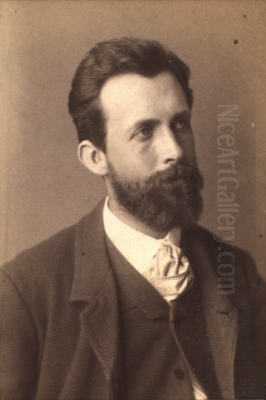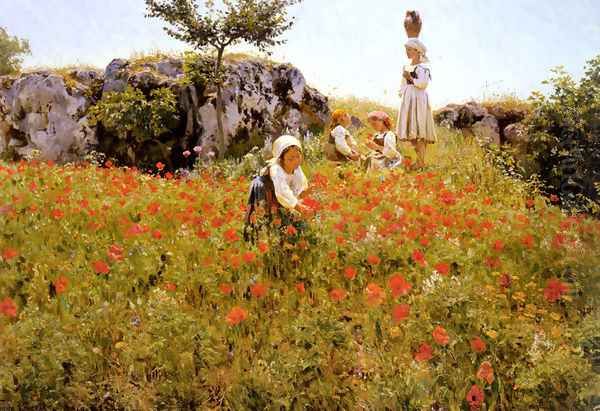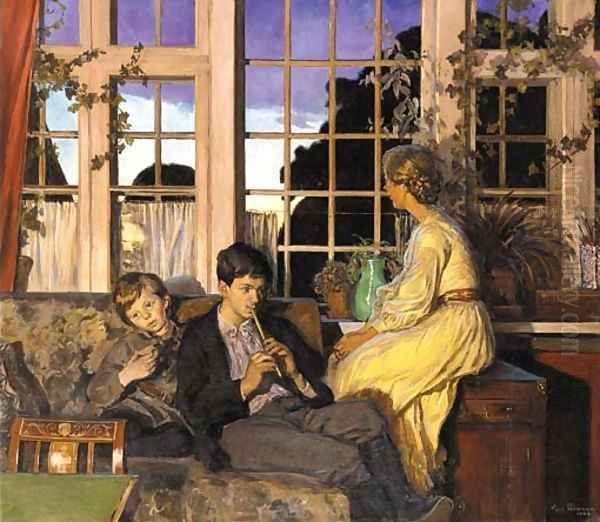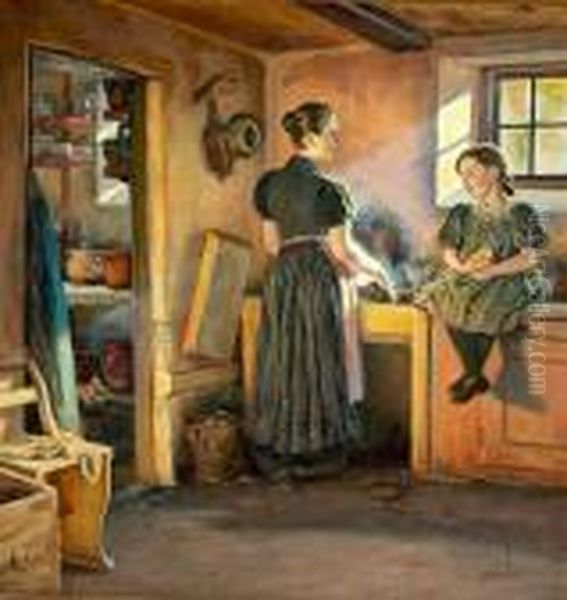
Viggo Pedersen stands as a significant figure in the landscape of Danish art, bridging the traditions of the 19th century with the burgeoning modern sensibilities emerging across Europe during his lifetime (1854-1926). A painter celebrated for his vibrant use of color, his commitment to Naturalism, and his evocative depictions of the Danish countryside and its people, Pedersen carved a distinct path, influenced by both his native artistic heritage and international currents like Impressionism and the Barbizon School. His work, characterized by a deep sensitivity to light and atmosphere, continues to resonate, offering insights into Danish culture and the evolution of European painting at the turn of the 20th century.
Early Life and Artistic Heritage
Born in Copenhagen in 1854, Viggo Pedersen entered a world already steeped in artistic tradition. His family background provided a fertile ground for his future career. His father, Vilhelm Pedersen, was a respected artist, perhaps most famous for being one of the first and most defining illustrators of Hans Christian Andersen's fairy tales. This connection not only placed the young Viggo within an artistic milieu but also likely exposed him early on to the power of visual storytelling and the nuances of Danish culture. The artistic lineage extended further, with his grandfather, Niels Pedersen, also being an artist. This familial environment undoubtedly nurtured his innate talents and set him on a course towards a life dedicated to the visual arts. Growing up surrounded by creativity fostered an early appreciation for drawing and painting.
Formal Education and Formative Influences
Pedersen's formal artistic training began earnestly, reflecting the structured approach common at the time. He initially attended C.V. Nielsen's drawing school, a preparatory step for many aspiring artists in Copenhagen, where he would have honed his fundamental skills. His ambition and talent led him to the prestigious Royal Danish Academy of Fine Arts in Copenhagen, which he entered in 1871. The Academy was the cornerstone of artistic education in Denmark, and here Pedersen came under the tutelage of prominent figures who shaped his early development.

Among his most influential teachers were P.C. Skovgaard and Janus La Cour. P.C. Skovgaard, a leading figure of the late Danish Golden Age, was renowned for his monumental and detailed landscapes, instilling in Pedersen a deep respect for the Danish natural world and meticulous observation. Janus La Cour, known for his more atmospheric and melancholic landscapes, likely encouraged Pedersen's sensitivity to mood and light. Further influences within the Academy included the art critic and painter Jens Adolf Jerichau, who advocated for a return to the grand styles of the Baroque and Renaissance, and Vilhelm Wancher, who encouraged his exploration of Naturalism. This blend of influences provided Pedersen with a rich, albeit complex, artistic foundation, balancing traditional Danish landscape painting with emerging European trends.
Travels and Exposure to International Art Movements
Like many ambitious artists of his generation, Pedersen understood the importance of travel for broadening his artistic horizons. He undertook several study trips across Europe, visiting Italy, Germany, and, crucially, France. These journeys were instrumental in exposing him to different artistic environments and contemporary movements that were reshaping European art. His time spent in Italy likely brought him into contact with its rich artistic history and perhaps the work of contemporary Danish artists residing there, such as Kristian Zahrtmann and Theodor Philipsen, known for their bold use of color and light.
His experiences in France, particularly his time living and working in Paris, proved profoundly influential. Paris was the undisputed center of the art world, buzzing with innovation. Here, Pedersen directly encountered the works of the Impressionists and the painters of the Barbizon School. The Barbizon painters, working in the Forest of Fontainebleau, emphasized direct observation of nature and plein air painting, a practice that resonated with Pedersen's interest in landscape. Impressionism, with its focus on capturing fleeting moments, the effects of light, and its vibrant, often unmixed colors, offered a revolutionary approach to painting reality. Pedersen absorbed these influences, particularly connecting with the Impressionists' handling of light and color, reportedly learning techniques from fellow Scandinavian artists in Paris, such as Erling Skak Nielsen.
Development of an Artistic Style: Naturalism, Color, and Light
Viggo Pedersen forged a style that, while distinctly his own, synthesized the various strands of his education and experiences. He remained deeply rooted in Naturalism, striving for a truthful representation of the world around him, particularly the landscapes and rural life of Denmark. This commitment aligned him with a broader European trend moving away from idealized academic subjects towards depictions of contemporary reality. However, his naturalism was infused with the lessons learned from French painting.

His palette became notably brighter and more vibrant than that of many of his Danish predecessors, reflecting the impact of Impressionism. He employed strong, sometimes contrasting colors to convey the intensity of sunlight or the richness of foliage. Yet, he also demonstrated great subtlety, capable of capturing the delicate nuances of changing light and atmosphere, often using softer brushwork and more muted tones to evoke specific moods, particularly in his depictions of dawn, dusk, or overcast days. His work often shows a dynamic interplay between light and shadow, used not just for descriptive accuracy but also for dramatic and emotional effect. He largely eschewed fantasy, preferring to find beauty and significance in the observed world, blending a realistic approach with a sensitive, almost romantic appreciation for nature's ephemeral qualities.
Predominant Themes and Subjects
Pedersen's oeuvre primarily revolves around landscape painting. He possessed a deep affection for the Danish countryside, and his works frequently depict its fields, forests, coastlines, and villages. He captured the changing seasons and the varying effects of weather with keen observation, celebrating the specific character of the Danish natural environment. His landscapes are rarely empty; they often include figures engaged in everyday activities, linking human life intrinsically to the natural world.
Beyond pure landscape, Pedersen explored themes of rural life and genre scenes. Paintings like Mother and Daughter in the Kitchen exemplify his interest in depicting intimate, domestic moments with warmth and realism. These works provide valuable glimpses into the daily lives of ordinary Danes at the time. Portraiture also formed part of his output, though it was perhaps less central than his landscape work. Furthermore, religious themes held a significant place in his art. He undertook commissions for church decorations, including murals, demonstrating his versatility and his engagement with traditional forms of artistic patronage. His approach to religious subjects often integrated them into naturalistic settings, grounding spiritual narratives in a tangible reality. The influence of artists like Jørgen Ringnis, known for church carvings, might be considered in the context of his ecclesiastical work.
Representative Works
Several paintings stand out as representative of Viggo Pedersen's style and thematic concerns. Picking Poppies likely showcases his vibrant use of color, capturing the brilliant red flowers against a sunlit landscape, embodying the beauty of the Danish summer. A Spring Day at Carlsberg suggests an urban or suburban landscape, perhaps depicting leisure or the burgeoning industrial presence within a natural setting, rendered with his characteristic attention to light. Enjoying the Sunset points directly to his preoccupation with atmospheric effects and the evocative qualities of light at the end of the day, a theme popular among both Romantic and Impressionist painters.

Aarhus above the Bathing Establishment likely combines landscape with elements of modern life, depicting a specific location with topographical accuracy but infused with atmospheric perspective. Kullenberg in Sweden indicates his exploration of landscapes beyond Denmark, capturing the dramatic coastal scenery of southern Sweden. The early work, Washing Scene by a Stream in Brittany (1882), created during his travels, is noted for showing the influence of Southern European light and his developing naturalistic observation applied to a foreign setting. Mother and Daughter in the Kitchen represents his engagement with intimate genre scenes, focusing on human relationships and domestic environments. These works collectively illustrate the breadth of his subjects and his consistent focus on color, light, and naturalistic representation.
Role in "Den Frie Udstilling" (The Free Exhibition)
Viggo Pedersen played an active role in a significant development within the Danish art world: the establishment of "Den Frie Udstilling" (The Free Exhibition) in 1891. At the time, the official art scene was dominated by the juried exhibitions at Charlottenborg Palace, home to the Royal Danish Academy. Many artists felt constrained by the conservative tastes of the jury and the limited opportunities to exhibit more progressive work.
Pedersen was among a group of dissenting artists who sought an alternative venue where they could showcase their work without the restrictions of the official Salon. Den Frie Udstilling was founded as an independent, artist-run cooperative, inspired by similar secession movements elsewhere in Europe, such as the Salon des Refusés in Paris. This initiative marked a crucial step towards modernizing the Danish art infrastructure. Pedersen remained loyal to Den Frie throughout his life, exhibiting there regularly. His involvement underscores his position within the more forward-looking segment of the Danish art community and his commitment to artistic freedom. His close collaborator, Joakim Skovgaard, likely shared similar sentiments and was part of this milieu striving for greater artistic independence.
Teaching Career and Influence
Beyond his own prolific output, Viggo Pedersen contributed to the development of Danish art through teaching. He held a position at the Royal Danish Academy of Fine Arts, where he taught anatomical drawing. This role allowed him to impart his knowledge and artistic principles to a younger generation of artists. His emphasis on accurate observation, combined with his understanding of light, color, and form, would have provided valuable training for his students.
One notable student influenced by Pedersen was Marie Sandholt. She became known for her portraits and genre scenes, and her work often reflects a sensitivity to color and light that may well have been nurtured under Pedersen's guidance. Through his teaching, Pedersen helped perpetuate certain artistic values while also encouraging students to engage with contemporary trends, thereby extending his influence beyond his own canvases. His dual role as a practicing artist and an educator solidified his importance within the Danish art ecosystem.
Recognition, Collections, and Legacy
Viggo Pedersen achieved considerable recognition during his lifetime, both within Denmark and internationally. His work was selected for inclusion in major international exhibitions, including the prestigious World's Fairs in Paris in 1889 and 1900, where he received honorable mentions and a bronze medal. Such accolades helped to build his reputation beyond Scandinavia.
His paintings were acquired by important public collections, ensuring their preservation and continued visibility. Key institutions holding his work include the Skovgaard Museum and the Nivaagaard Collection in Denmark, as well as national galleries in Oslo, Stockholm, and Helsinki. The presence of his art in these major Nordic museums attests to his established status and the high regard in which his work was held.
Viggo Pedersen's legacy lies in his contribution to Danish Naturalism and his skillful integration of international influences, particularly Impressionism, into a distinctly Danish context. He is remembered for his evocative landscapes, his mastery of color and light, and his sensitive depictions of rural life. He successfully navigated the transition from the Danish Golden Age tradition towards a more modern artistic language. As an artist, a teacher, and a participant in the founding of Den Frie Udstilling, he played a multifaceted role in shaping the course of Danish art at a pivotal moment in its history. His work continues to be appreciated for its aesthetic qualities and its insightful portrayal of the Danish spirit and landscape.
Conclusion
Viggo Pedersen remains a respected and important painter within the canon of Danish art history. Emerging from a rich artistic family background and educated at the Royal Danish Academy, he absorbed the lessons of his national heritage while embracing the innovations sweeping across Europe. His travels, especially to France, exposed him to the Barbizon School and Impressionism, profoundly impacting his use of color and his approach to light and landscape. He dedicated much of his career to capturing the essence of the Danish countryside and the lives of its inhabitants, employing a vibrant Naturalism infused with atmospheric sensitivity. His role in establishing Den Frie Udstilling highlights his progressive stance, while his teaching ensured his influence extended to subsequent generations. Through his beautiful and evocative paintings, housed in major Nordic collections, Viggo Pedersen's vision of Denmark endures.